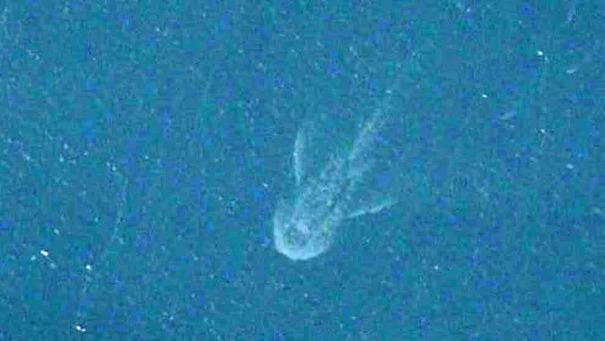Hey, remember when everyone was talking about the Loch Ness Monster Apple Maps satellite photo a couple weeks ago? Wonder why the beastly image hasn’t been reproduced before or since, or why the zoologic community isn’t descending upon the lake with renewed vigor thanks to this new evidence? You can probably guess why.

A blurry something-or-other. What do you see?
Putting the Pieces Together
Or maybe not. It’s kind of a natural tendency to try to piece together – both consciously and unconsciously – a coherent explanation for what we’re seeing. Our perception isn’t as simple as projecting the data derived from our eyes on a brain screen. We’re not truly envisioning the world how it actually is, but how our brain constructs the information it’s given, “filling in” gaps created by blind spots and other obstructions to fit previously catalogued instances of what something “should” look like.

Believe it or not, this is a static image. Notice that when staring at a particular white dot, many others seem black. Now look at a different one and see what happens. Your brain wants to make the dots black to fit the color contrast.

Although it’s not always easy to discriminate. Jesus Christ or Charlie Manson?

Photo credit: NASA

If you can recognize this isn’t a real person, you should understand that the same brain trick happens a lot.
Cameras Do Lie
The light on Mars may in fact be due to the detection of cosmic rays, pointing out a peculiarity of collecting data in an alien setting. It’s often too easy to skip those idiosyncrasies and jump straight to interpreting what we see, forgetting, like our eyes, cameras don’t always give a flawless record of reality. For all their clarity, modern digital cameras have plenty of their own “blind spots.”
The relatively new photographic phenomenon of “spirit orbs” is actually caused by retroflection, when a larger than usual portion of the flash is reflected directly into the lens. While some paranormalists prefer to think they’re ghosts (not sure what leads them to that conclusion), orbs are almost always the result of dust particles suspended in the air. Why don’t we see them more often, then? We do! You can even make some yourself! I did! Accidentally!

Taken on one of my job sites. Either a technological artifact or those buried oil drums were haunted.

A swarm of so-called rods.
The marine ecology blog Southern Fried Science explains that the image looks like a Frankenstein hodgepodge of things because that’s exactly what it is. Satellite images aren’t snapped instantly like from a cell phone, but are instead “stitched together” from shots taken throughout the device’s orbital path. When creating such panoramas, it’s inevitable that sometimes things just won’t look right or some details – like the truck/boat center – could be washed out. While far from obvious, it’s important to consider the limitations of the recording device before speculating on the true nature of an image.

Other images from different angles make the identification pretty easy.
The Never-Ending Story
But some people so want to believe that they’ll skip a step on the way to their desired outcome. They might even persist after rock-solid evidence is presented. Consider this reenactment of actual events (so it must be true!) from the end of the Monsterquest episode:
Narrator: So are all rods bugs? [pause]
Dog: Well, I think that’s what you just showed us. I don’t see any reason to invent a new branch of physics or enlist beings from the fourth dimension to explain something you just reproduced exactly in some guy’s garden.
Narrator: Not necessarily.
Dog: Oh, fuck me.
Join the AIPT Patreon
Want to take our relationship to the next level? Become a patron today to gain access to exclusive perks, such as:
- ❌ Remove all ads on the website
- 💬 Join our Discord community, where we chat about the latest news and releases from everything we cover on AIPT
- 📗 Access to our monthly book club
- 📦 Get a physical trade paperback shipped to you every month
- 💥 And more!












